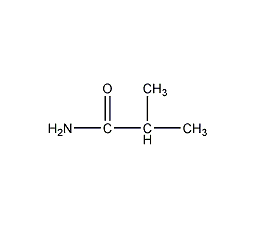
Structural formula
| Business number | 05T3 |
|---|---|
| Molecular formula | C4H9NO |
| Molecular weight | 87.12 |
| label |
2-methylpropionamine, 2-Methylpropionamide, Isopropylformamide, Pharmaceutical R&D |
Numbering system
CAS number:563-83-7
MDL number:MFCD00008019
EINECS number:209-265-9
RTECS number:TX1475000
BRN number:1737615
PubChem number:24848653
Physical property data
1. Properties: White needle-like crystals.
2. Density (g/mL, 25/4℃): 1.013
3. Melting point (℃): 127-129
4. Boiling point ( ºC): 216-220
5. Solubility: Easily soluble in water, alcohol, chloroform, slightly soluble in ether.
Toxicological data
None yet
Ecological data
None yet
Molecular structure data
5. Molecular property data:
1. Molar refractive index: 24.10
2. Molar volume (cm3/mol): 95.7
3. Isotonic specific volume (90.2K): 222.7
4. Surface tension (dyne/cm): 29.3
5. Polarizability (10-24cm3): 9.55
Compute chemical data
1. Reference value for hydrophobic parameter calculation (XlogP): 0.2
2. Number of hydrogen bond donors: 1
3. Number of hydrogen bond acceptors: 1
4. Number of rotatable chemical bonds: 1
5. Number of tautomers: 3
6. Topological molecule polar surface area 43.1
7. Number of heavy atoms: 6
8. Surface charge: 0
9. Complexity: 58.6
10. Number of isotope atoms: 0
11. Determine the number of atomic stereocenters: 0
12. Uncertain number of atomic stereocenters: 0
13. Determine the number of chemical bond stereocenters: 0
14. Number of uncertain chemical bond stereocenters: 0
15. Number of covalent bond units: 1
Properties and stability
1. Exist in smoke.
Storage method
None yet
Synthesis method
1. Brief description of the production method
It is obtained by chlorination of isobutyric acid to obtain isobutyryl chloride, and then amidation. Add isobutyryl chloride dropwise to concentrated ammonia water under strong stirring, and control the addition rate so that the temperature does not exceed 15°C. After the addition was completed, the mixture was stirred for another 1 hour, and the mixture was evaporated to dryness under reduced pressure. The residue was isobutylamide and ammonium chloride. Add ethyl acetate to the residue, boil for 10 minutes, filter, and then dry under vacuum to obtain the finished product.
Purpose
2. Uses
Used in organic synthesis,Prepare isobutyronitrile, etc.

 微信扫一扫打赏
微信扫一扫打赏

